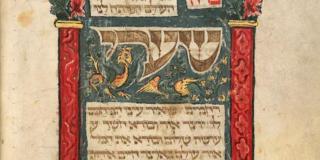
David Bar Pesaḥ (Scribe)
David bar Pesaḥ Maḥzor
Manuscript on vellum
Germany, 14th century
Beauty and History: The Collection’s Oldest Manuscripts
The Dorot Jewish Division is home to an outstanding collection of Hebrew manuscripts that are renowned for their exceptional beauty and historical significance. While some of the manuscripts have long been recognized as iconic items from the Library’s collection and featured in numerous exhibitions, others remain less famous and are showcased here for the first time.
Extraordinary artifacts in this section include items from the Library’s Manuscripts and Archives Division, underscoring the presence of Jewish materials across the Library’s research collections. This includes the oldest artifacts in the online exhibition: amulets dating to the fifth and sixth centuries, found in Jewish tombs in the early 20th century in present-day Jordan.
Overall, the selection of manuscripts featured here, in addition to their striking visual appearance, give a sense of the geographical and cultural diversity of Jewish traditions across the globe. One can explore precious rarities from North Africa, Asia, Italy, Germany, and France spanning more than a thousand years. The manuscripts also provide insights into more practical aspects of Jewish tradition, such as protective amulets, ketubbot (marriage certificates), prayer books, kabbalistic treaties, calendars, Esther scrolls for reading and enjoyment over the Purim festival, and Haggadot, intended for reading during Passover. Notably, some manuscripts, such as the Samaritan Bible from the 13th century, demonstrate the historical trajectory of traditions that utilized the Hebrew script but formed their own unique religious and cultural identity.






